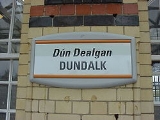
Dundalk railway station
Encyclopedia
Dundalk Clarke railway station serves Dundalk
in County Louth
, Ireland
. It consists of an island platform
, with a bay
facing south. It is served by the Dublin-Belfast "Enterprise" express trains as well as local Commuter services to and from Dublin. There is a small museum located in one of the station buildings here, displaying various railway artifacts and photographs.
line), becoming Dundalk Station in June 1894. It was given the name Clarke on 10 April 1966 in commemoration of Tom Clarke
, one of the executed leaders of the Easter Rising of 1916
. In 2004 Clarke station was re designated Dundalk International Train Depot due to the fact that it links Northern Ireland and the Republic of Ireland. However, this unique status was never implemented into official designation and is still termed Clarke Station by Iarnrod Eireann. It was officially opened by the then Foreign Affairs Minister Dermot Aherne, a native of Dundalk, on 6 May 2004.
covered walkway, and by a 21st century lift for disabled access. The station is noted for its fine iron, glass, and polychromic brickwork
. It has been said to be the finest station on the Dublin-Belfast line.
Dundalk
Dundalk is the county town of County Louth in Ireland. It is situated where the Castletown River flows into Dundalk Bay. The town is close to the border with Northern Ireland and equi-distant from Dublin and Belfast. The town's name, which was historically written as Dundalgan, has associations...
in County Louth
County Louth
County Louth is a county of Ireland. It is part of the Border Region and is also located in the province of Leinster. It is named after the town of Louth. Louth County Council is the local authority for the county...
, Ireland
Ireland
Ireland is an island to the northwest of continental Europe. It is the third-largest island in Europe and the twentieth-largest island on Earth...
. It consists of an island platform
Island platform
An island platform is a station layout arrangement where a single platform is positioned between two tracks within a railway station, tram stop or transitway interchange...
, with a bay
Bay platform
Bay platform is a railway-related term commonly used in the UK and Australia to describe a dead-end platform at a railway station that has through lines...
facing south. It is served by the Dublin-Belfast "Enterprise" express trains as well as local Commuter services to and from Dublin. There is a small museum located in one of the station buildings here, displaying various railway artifacts and photographs.
History
The station opened on 15 February 1849 as Dundalk Junction (being located at the Junction of the Dublin-Belfast line and the Dundalk and EnniskillenEnniskillen
Enniskillen is a town in County Fermanagh, Northern Ireland. It is located almost exactly in the centre of the county between the Upper and Lower sections of Lough Erne. It had a population of 13,599 in the 2001 Census...
line), becoming Dundalk Station in June 1894. It was given the name Clarke on 10 April 1966 in commemoration of Tom Clarke
Tom Clarke (Irish republican)
Thomas James "Tom" Clarke was an Irish revolutionary leader and arguably the person most responsible for the 1916 Easter Rising. A proponent of violent revolution for most of his life, he spent 15 years in prison...
, one of the executed leaders of the Easter Rising of 1916
Easter Rising
The Easter Rising was an insurrection staged in Ireland during Easter Week, 1916. The Rising was mounted by Irish republicans with the aims of ending British rule in Ireland and establishing the Irish Republic at a time when the British Empire was heavily engaged in the First World War...
. In 2004 Clarke station was re designated Dundalk International Train Depot due to the fact that it links Northern Ireland and the Republic of Ireland. However, this unique status was never implemented into official designation and is still termed Clarke Station by Iarnrod Eireann. It was officially opened by the then Foreign Affairs Minister Dermot Aherne, a native of Dundalk, on 6 May 2004.
Architecture
The station was designed c. 1845 by John McNeil. The ticket office and modern waiting area are located at road level, whereas the station proper is beneath this at track level. The two sections are connected by a VictorianVictorian architecture
The term Victorian architecture refers collectively to several architectural styles employed predominantly during the middle and late 19th century. The period that it indicates may slightly overlap the actual reign, 20 June 1837 – 22 January 1901, of Queen Victoria. This represents the British and...
covered walkway, and by a 21st century lift for disabled access. The station is noted for its fine iron, glass, and polychromic brickwork
Brickwork
Brickwork is masonry produced by a bricklayer, using bricks and mortar to build up brick structures such as walls. Brickwork is also used to finish corners, door, and window openings, etc...
. It has been said to be the finest station on the Dublin-Belfast line.

